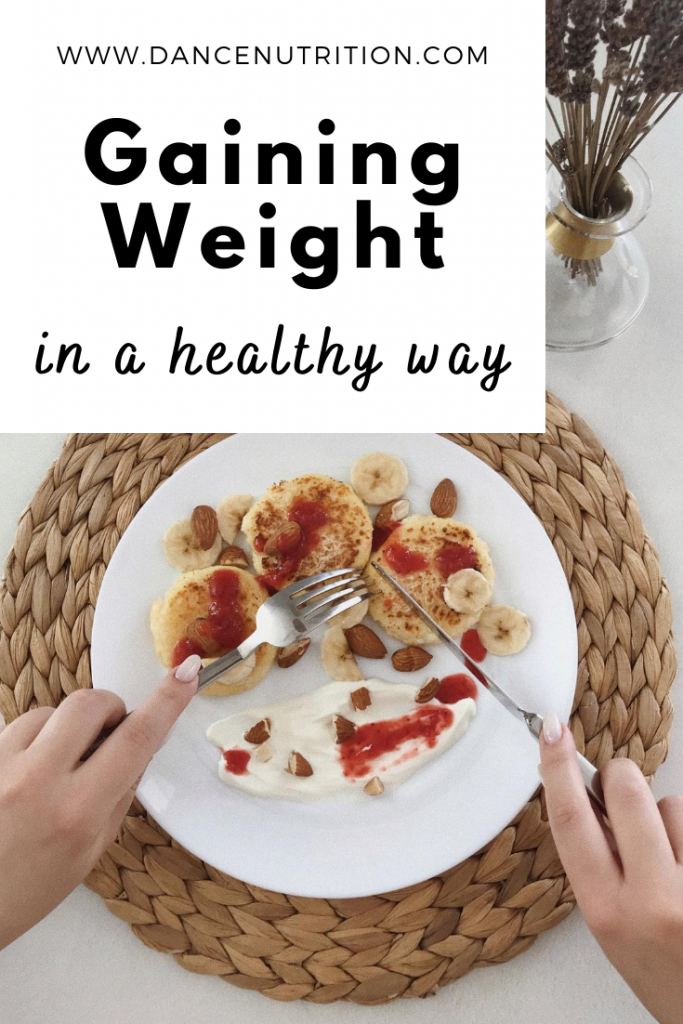When is weight gain necessary for a stronger and injury-free performance? This will depend on your unique situation— dance schedule, weight history, nutrition history, and injury status, to name a few. It can be challenging to come to terms with the need for weight gain, especially if you’ve struggled with a fear of weight gain or a disordered relationship with food. As a starting point, let’s discuss the key reason for needing to gain weight.
Am I “underweight” as a dancer?
Being underweight is an unfortunate product of both the ill-advised standards that the dance community and the challenges of fueling for intense activity. Some dancers argue that aspects of performance such as casting, partnering, and overall technical ability might be improved when underweight.
However, the consequences of maintaining a weight that is too low for one’s height outweigh these perceived benefits. Relative Energy Deficiency in Sport or RED-S refers to the spectrum of interconnected health ailments experienced alongside the pursuit of low body weight. In addition, there are the realities of ideal weights for dancers— most based on falsities and bias.
Identifying the need for weight gain
Though most health professionals rely on BMI (Body Mass Index) for assessing one’s weight status, this measurement is highly unreliable— especially for athletes (and dancers). BMI does not account for variations in body composition and therefore should not be used as a sole diagnostic for weight change or health status. Rather, growth trends, bone mass, and behaviors should be examined. Most importantly, dancers should contact a licensed medical professional such as a Registered Dietitian Nutritionist to assess their weight status and when gains are expected, consider these tips for progress.
#1: Plan Ahead
Planning is especially important for dancers wanting to gain weight— you’re more likely to pack balanced options that incorporate carbohydrates, proteins, and fats. This nutrient mix provides your body with the components needed for anabolic growth.
#2: Eat Frequently
Aim to eat frequent meals throughout the day— each may be smaller, but with energy-dense ingredients (see below). Every 2-3 hours is ideal, depending on your schedule. If you’re struggling to get food between classes, read this blog post to learn more about constructing convenient snacks for busy schedules.
Planning a bedtime snack is also encouraged. One that incorporates slow-digesting complex carbohydrates and a source of protein will prevent midnight blood sugar spikes and leave you feeling fueled throughout the next morning. Whole milk yogurt topped with bananas and chocolate chips is a favorite!
#3: Optimize Your Ingredients
To get the biggest bang per bite, prioritize energy- and nutrient-dense foods. These are packed with the macronutrients (carbs, protein, and fat) in the smallest volume possible. Here are a handful of ingredients to rely on:
- Quinoa is complete protein, packed with fiber, vitamins, and minerals, including iron and magnesium.
- Avocado is rich in fats, avocados provide a creamy texture and are packed with vitamins, minerals, and antioxidants, such as potassium, vitamin K, and folate.
- Potatoes (any type) are high in complex carbohydrates, fiber, and vitamins A and C. Sweet potatoes are also rich in vitamin A.
- Nuts and Seeds like almonds, walnuts, cashews, peanuts, chia seeds, and flaxseeds are all nutrient-dense sources of fats, protein, fiber, vitamins, and minerals, including magnesium and zinc.
- Yogurt, especially whole milk varieties, offers a boost of probiotics for gut health and calcium for bone health.
- Eggs are a complete protein source, containing all nine essential amino acids, as well as vitamins D, B12, and choline, which support brain health and energy production.
- Beans and legumes like lentils, chickpeas, and black beans are rich in protein, fiber, and complex carbohydrates, providing sustained energy and supporting digestive health.
Quick tips: weight gain for dancers
- Add oats and almond butter to smoothies.
- Add seeds (sunflower, flax, chia, hemp) to oatmeal, yogurt, and cereal.
- Swap bread with bagels (they’re denser and more filling!)
- Choose nuts and nut/seed butter for a calorically dense topping that is easy to pair with toast or fruit.
- Add 2 cups (about 2 servings) of a dense breakfast cereal (or 1 cup of granola) to whole-milk yogurt.
- Add oils to meals while cooking
- Use olive oil for salads, canola or avocado oil for high-heat cooking, and avocado or coconut oil for baking.
- Add sliced avocado (aim for a half standard avocado) to sandwiches, eggs, and smoothies.
- Skip the diet foods. These are often labeled as “low fat,” “fat-free,” and “sugar-free.” Examples include powdered peanut butter and fat-free dairy products.



